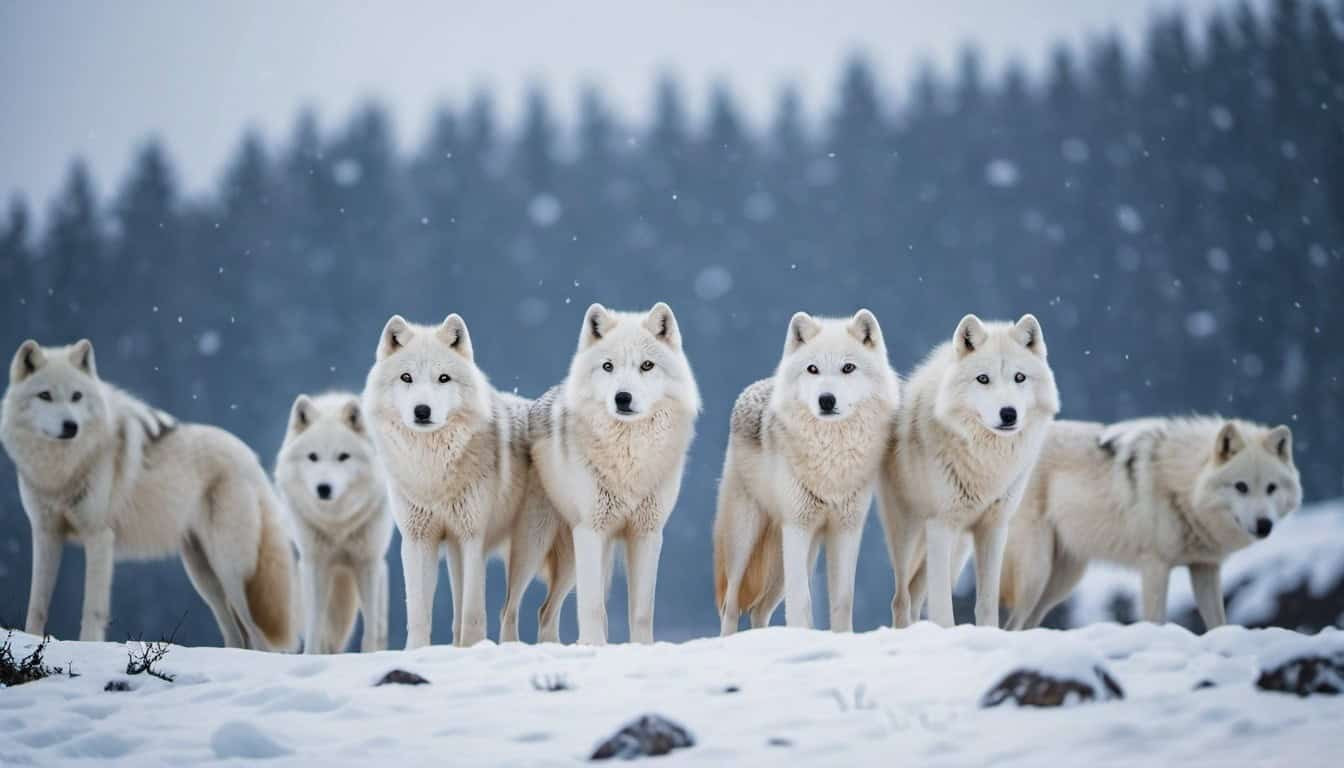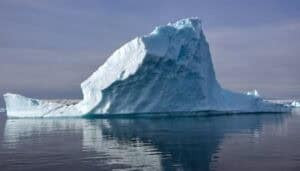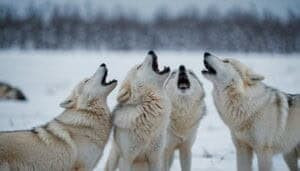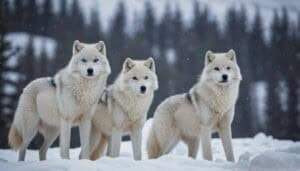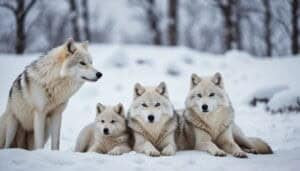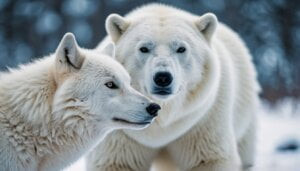Introduction
Arctic wolves are remarkable predators adapted to one of the harshest environments on Earth. Their hunting behaviors vary significantly with the changing seasons, impacting their survival and the broader ecosystem
This article explores how Arctic wolves adapt their hunting strategies in response to seasonal prey availability, environmental challenges, and pack dynamics. We will delve into the specific adaptations these wolves exhibit during winter, the impact of environmental factors on their hunting success, and the energetic demands faced in different seasons
Additionally, we will examine the influence of climate change on their hunting behaviors and prey patterns
Seasonal Prey Availability
The availability of prey is a crucial factor influencing the hunting behaviors of Arctic wolves. These predators must adapt their strategies to the changing prey populations as the seasons shift from summer to winter
Summer Prey
During the summer months, Arctic wolves primarily prey on smaller animals that are more abundant and accessible
The snow melts, revealing vegetation that attracts a variety of herbivores. Key prey species during this period include Arctic hares, lemmings, and migratory birds. These smaller animals provide essential nutrition for the wolves but require different hunting tactics compared to winter prey
One notable study observed that Arctic wolves increase their foraging activity in the summer, targeting the higher density of small mammals and birds . The lack of snow cover allows the wolves to move more swiftly and with greater stealth, making ambush tactics more effective
The summer months also see a rise in the presence of caribou calves, which are easier targets than the fully grown adults. This seasonal abundance of young and smaller prey helps sustain the wolf population during the warmer months
Interestingly, Arctic wolves may also scavenge more in the summer due to the increased presence of other predators and scavengers that leave behind carcasses. This behavior reduces the energy expenditure required for hunting and maximizes the nutritional intake from available resources
Winter Prey
As winter sets in, the hunting landscape for Arctic wolves undergoes a dramatic transformation. The thick snow cover and frigid temperatures challenge both predators and prey. Larger animals become the primary focus for wolves during this season due to their greater caloric value and the scarcity of smaller prey
Caribou and muskoxen are the main targets for Arctic wolves in winter. These large herbivores are well-adapted to the harsh environment, making them formidable opponents
Wolves rely heavily on pack cooperation to take down such sizeable prey, which involves strategic planning and coordinated attacks. The wolves often use deep snow to their advantage, tiring out their prey before delivering a fatal bite
A study conducted in the Canadian Arctic highlighted that Arctic wolves’ hunting success rates vary with the snow depth and hardness. Deeper, softer snow tends to hinder prey movement more than it does the wolves, giving the predators a significant advantage
However, in extremely harsh conditions, even wolves face difficulties, leading to increased starvation rates and reliance on scavenging
The winter prey dynamics also influence the wolves’ territorial behavior. To ensure a steady supply of food, wolf packs may expand their territories, leading to increased encounters and conflicts with rival packs. This territorial expansion is crucial for accessing different herds of caribou and muskoxen that migrate across vast distances in search of food
Winter Hunting Adaptations
Winter presents Arctic wolves with some of the most challenging conditions for survival. To thrive in such a harsh environment, they exhibit several physical and behavioral adaptations that enhance their hunting success
Physical Adaptations
Arctic wolves are built to withstand extreme cold and navigate through deep snow
One of their most notable physical adaptations is their thick, double-layered coat, which provides excellent insulation against frigid temperatures. The outer layer of long guard hairs repels water and snow, while the dense underfur traps body heat
Their paws are another crucial adaptation. Arctic wolves have large, furry paws that distribute their weight more evenly over the snow, preventing them from sinking too deeply. This adaptation is akin to wearing snowshoes and allows them to move swiftly and efficiently across the snow-covered terrain
The fur between their toes also provides additional insulation and traction, reducing the risk of frostbite and slips
In terms of body size, Arctic wolves tend to be smaller and more compact than their southern relatives. This reduced surface area helps minimize heat loss, a critical factor in conserving energy during the long winter months
Additionally, their shorter ears and muzzle reduce exposure to cold, further conserving body heat
Behavioral Strategies
Arctic wolves exhibit several behavioral strategies to increase their hunting success during winter
One key strategy is pack cooperation. Hunting large prey such as caribou and muskoxen requires coordinated efforts from multiple pack members. Wolves use a combination of stealth, endurance, and tactical maneuvers to isolate and exhaust their prey before making the kill. This cooperative hunting increases the efficiency of their efforts and ensures that the entire pack can share in the spoils
Another important behavioral adaptation is their hunting technique. In deep snow, Arctic wolves utilize the terrain to their advantage. They often hunt by driving their prey into areas where the snow is deep and soft, making it harder for the prey to escape. This strategy reduces the energy expenditure needed to chase and catch their prey
Arctic wolves also display a high level of adaptability in their hunting methods
For example, during periods of low prey availability, they may scavenge more frequently or target different types of prey, including smaller mammals or birds that remain active during winter. This flexibility in diet helps them survive when their preferred prey is scarce
The wolves’ social structure and communication are also finely tuned to support their hunting activities. Howls are used not only to maintain pack cohesion but also to coordinate movements and strategies during hunts. This communication is crucial, especially in the vast and featureless Arctic landscape where visibility can be limited by snow and ice
Research has shown that Arctic wolves can cover extensive distances in search of food. One study recorded wolves traveling over 30 miles in a single day during winter hunting expeditions. This endurance is vital for tracking migrating prey and ensuring the pack’s survival in an environment where food sources can be widely dispersed
Pack Dynamics and Hunting
The pack dynamics of Arctic wolves play a critical role in their hunting success. The structure, size, and cooperative behaviors of the pack determine how effectively they can hunt and capture prey, especially in the challenging Arctic environment
Role of Pack Size
The size of an Arctic wolf pack can vary significantly, and this variation impacts their hunting strategies and success rates. Larger packs have the advantage of numbers, which allows them to take down larger prey more efficiently
For example, a pack of 10-15 wolves can successfully hunt caribou or muskoxen by surrounding and exhausting the prey, whereas smaller packs or lone wolves would struggle with such large targets
A study conducted in the Arctic region found that larger packs have higher hunting success rates and can cover more ground when searching for food. This study, published in the Canadian Journal of Zoology, highlighted that packs of six or more wolves had a 75% success rate in hunting caribou, compared to just 40% for smaller packs of three or fewer wolves
The increased success rate in larger packs ensures that more members of the group receive sufficient nutrition, which is crucial for survival during the harsh winter months
However, larger pack sizes also come with increased competition for food within the pack. When resources are scarce, this can lead to hierarchical disputes and changes in pack structure. In times of abundance, larger packs are more stable and cooperative, but during food shortages, they may split into smaller groups to reduce competition and increase individual survival chances
Cooperative Hunting Techniques
Cooperation is key to the hunting success of Arctic wolves. Their hunting strategies are highly organized and involve complex social behaviors and communication
One common technique is the relay hunt, where wolves take turns chasing the prey, allowing each member of the pack to conserve energy while maintaining pressure on the target
Arctic wolves also employ strategic positioning during hunts. Pack members often spread out and attempt to encircle the prey, cutting off escape routes and isolating weaker or younger individuals from the herd
This method is particularly effective against caribou, which rely on speed and endurance to escape predators. By forcing the caribou into deep snow or towards other pack members, the wolves increase their chances of a successful kill
Communication plays a vital role in these cooperative hunts. Wolves use vocalizations, body language, and scent marking to coordinate their movements and strategies. Howling, for example, helps maintain pack cohesion and synchronize attacks, even when visibility is low due to snowstorms or the vast Arctic terrain
A notable example of cooperative hunting behavior was observed in a pack of Arctic wolves in Greenland. Researchers documented how the pack used the terrain to their advantage, driving a herd of muskoxen into a narrow valley where escape was difficult
The wolves then methodically isolated a calf from the herd, showcasing their ability to plan and execute complex hunting strategies
These cooperative behaviors are not only crucial for hunting but also for maintaining the social bonds within the pack. Successful hunts reinforce the hierarchical structure, with the alpha pair typically eating first, followed by subordinate members. This hierarchy ensures order and stability within the pack, which is essential for their long-term survival in the Arctic
Environmental Impact on Hunting
The Arctic environment, characterized by extreme conditions, significantly influences the hunting behaviors and success of Arctic wolves. Factors such as snow cover, terrain, and weather conditions create both challenges and opportunities for these predators
Snow Cover and Terrain
Snow cover plays a pivotal role in the hunting dynamics of Arctic wolves. The depth, hardness, and distribution of snow can either facilitate or hinder their hunting efforts. In regions with deep, soft snow, wolves gain an advantage over their prey
Large herbivores like caribou and muskoxen struggle to move quickly through such snow, whereas wolves, with their wide paws, can traverse it more efficiently. This disparity in mobility allows wolves to tire out their prey more quickly and make successful kills
A study published in the Journal of Wildlife Management noted that Arctic wolves’ hunting success rates increased by 30% in areas with deeper snow compared to regions with shallow snow. This increase is attributed to the physical advantage wolves have in deeper snow, which slows down their prey and reduces the distance and energy required to make a kill
Conversely, in areas where snow is hard and crusted, prey animals can move more swiftly, making it harder for wolves to catch them. In these conditions, wolves may alter their hunting strategies, such as focusing on ambush tactics or targeting prey already weakened by the harsh environment
The Arctic terrain itself also influences hunting behaviors. Wolves use the landscape to their advantage, utilizing natural features like valleys, hills, and ice formations to corral and isolate prey
For example, wolves may drive caribou into narrow passes or onto ice floes, where escape is more difficult. These strategies demonstrate the wolves’ adaptability and understanding of their environment
Weather Conditions
Weather conditions in the Arctic are notoriously harsh and unpredictable, posing significant challenges for both predators and prey. Severe cold, blizzards, and strong winds can impact the visibility, mobility, and survival rates of Arctic wolves and their prey
During blizzards, reduced visibility can hinder wolves’ ability to locate and pursue prey. However, wolves have adapted by developing keen senses of smell and hearing, which help them detect prey even in poor visibility
Moreover, their thick fur and physiological adaptations allow them to withstand extreme cold while continuing their hunting activities
A study on the impact of weather on Arctic wolf hunting, published in the Canadian Journal of Zoology, found that wolves’ hunting success decreased by 20% during severe weather conditions. Despite these challenges, wolves have shown remarkable resilience and adaptability, often increasing their foraging efforts immediately after a storm when prey might be more vulnerable
Additionally, extreme cold affects the energy expenditure of Arctic wolves. Maintaining body heat in subzero temperatures requires significant energy, making efficient hunting even more critical for survival
During periods of intense cold, wolves may alter their hunting patterns, focusing on shorter, high-energy hunts to conserve energy
The seasonal variations in daylight also influence hunting behaviors. During the Arctic winter, with its extended periods of darkness, wolves rely more on their senses and less on visual cues to hunt
Conversely, the long daylight hours of summer provide more opportunities for wolves to hunt and forage, allowing them to maximize their energy intake during the warmer months
These environmental factors highlight the complex interplay between the Arctic wolves’ adaptations and the challenging conditions they face. Their ability to modify hunting strategies based on snow cover, terrain, and weather conditions underscores their resilience and adaptability in one of the most extreme environments on Earth
Energetic Demands and Survival
The energetic demands of Arctic wolves fluctuate with the changing seasons, impacting their survival strategies. These wolves must efficiently manage their energy expenditure to endure the harsh conditions of their environment
Energy Expenditure in Summer
During the summer months, Arctic wolves experience a relative abundance of food resources
The presence of smaller prey such as Arctic hares, lemmings, and migratory birds, as well as the availability of caribou calves, allows wolves to replenish their energy reserves after the long winter. However, hunting smaller prey requires frequent and shorter hunting trips, which can still be energetically costly
A study published in the Journal of Wildlife Management found that Arctic wolves’ energy expenditure in summer is characterized by a balance between hunting effort and resting periods. Wolves typically hunt during cooler parts of the day, such as early morning and late evening, to avoid overheating and to maximize their hunting efficiency
This diurnal pattern helps conserve energy while taking advantage of prey activity periods
Additionally, the increased daylight hours in summer provide more opportunities for foraging and hunting. Wolves can hunt multiple times a day, which is crucial for feeding growing pups and maintaining the overall health of the pack
The abundance of food during summer also allows wolves to build up fat reserves, which are essential for surviving the leaner winter months
Energy Expenditure in Winter
Winter poses a significant challenge for Arctic wolves, as the availability of prey decreases and the energetic cost of maintaining body heat increases
The scarcity of small prey forces wolves to focus on larger animals like caribou and muskoxen, which require coordinated pack hunting efforts and higher energy expenditure
In the winter months, Arctic wolves must travel greater distances to find food. Research has shown that wolves can cover up to 20 miles a day in search of prey, with some packs traveling even further during periods of extreme scarcity. This increased travel distance, combined with the physical exertion of hunting in deep snow and cold temperatures, raises the wolves’ energy needs
A key survival strategy during winter is the conservation of energy. Wolves achieve this by minimizing unnecessary movements and maximizing rest periods between hunts. The pack’s cooperative hunting behavior also plays a critical role in distributing the energy expenditure among members, ensuring that no single wolf is overly exhausted
The energetic demands of winter are further compounded by the need to maintain body heat in subzero temperatures
Arctic wolves have adapted to this by developing thick fur and a lower surface area to volume ratio, which helps reduce heat loss. Despite these adaptations, the metabolic rate of wolves increases significantly in cold weather, requiring them to consume more calories to stay warm
A study published in the Canadian Journal of Zoology found that Arctic wolves’ daily caloric intake in winter is approximately 3,000-3,500 calories, compared to about 2,000-2,500 calories in summer. This increase highlights the additional energy required for thermoregulation and the physical demands of hunting in winter conditions
The ability of Arctic wolves to adapt their energy expenditure strategies to seasonal changes is crucial for their survival. By efficiently managing their energy reserves, these wolves can endure the harsh winter months and take full advantage of the relative abundance of resources during summer
Climate Change and Hunting Behaviors
Climate change is altering the Arctic environment, impacting the hunting behaviors and survival strategies of Arctic wolves. These changes influence prey availability, habitat conditions, and the overall ecosystem dynamics
Effects of Warming Temperatures
The Arctic region is experiencing some of the most rapid warming on the planet, with temperatures rising at twice the global average rate
This warming has profound effects on the Arctic wolves’ habitat and hunting behaviors. One significant impact of warming temperatures is the alteration in the timing and extent of sea ice melt and snow cover
Earlier snowmelt and reduced snow cover can lead to changes in prey distribution and availability. For example, caribou, a primary prey species for Arctic wolves, may alter their migratory patterns in response to changing vegetation and snow conditions
A study published in the Global Change Biology journal found that shifts in caribou migration due to climate change have led to mismatches between wolf packs and caribou herds, resulting in decreased hunting success for wolves
Warmer temperatures also affect the physical condition of the prey. Caribou and muskoxen may experience higher parasite loads and reduced body condition due to the longer and warmer summers, making them weaker and potentially more vulnerable to predation
However, these changes can be a double-edged sword, as weakened prey may not always be sufficient to sustain the wolves’ caloric needs, especially if overall prey numbers decline
Additionally, the reduction in sea ice affects the hunting grounds available to Arctic wolves. Wolves in some regions rely on sea ice to travel and hunt, particularly for marine mammals like seals. As the ice diminishes, these hunting opportunities decrease, forcing wolves to adapt to new hunting strategies or face increased competition on land
Changes in Prey Patterns
Climate change not only affects the availability and condition of existing prey species but also introduces new dynamics into the Arctic ecosystem
One notable change is the northward shift of temperate species into the Arctic region. As the climate warms, species such as red foxes and deer are expanding their range into traditionally Arctic habitats, which can have both direct and indirect effects on Arctic wolves
The presence of new prey species can offer alternative food sources for Arctic wolves, potentially alleviating some of the pressures caused by changes in traditional prey populations
For instance, deer populations moving northward could provide additional hunting opportunities for wolves. However, this also brings new competition and potential disease transmission, complicating the wolves’ survival strategies
Research in the Journal of Wildlife Management has documented instances where Arctic wolves have adapted their diet to include more temperate prey species, highlighting their flexibility and resilience
However, this adaptation is not without challenges. The introduction of new prey species can disrupt existing predator-prey dynamics and may lead to unforeseen ecological consequences
Moreover, the encroachment of other predators, such as red foxes, into the Arctic can lead to increased competition for food resources
Red foxes, being smaller but highly adaptable, can compete with Arctic wolves for smaller prey such as hares and birds. This interspecific competition can strain the already limited food resources, further challenging the wolves’ ability to find sufficient nourishment
Another impact of climate change is the alteration of the vegetation landscape in the Arctic. Warmer temperatures and longer growing seasons are causing shifts in plant communities, affecting the habitats and food sources of herbivores like caribou and hares
These changes can cascade through the food web, ultimately impacting Arctic wolves’ hunting behaviors and success rates
Conclusion
The hunting behaviors of Arctic wolves are intricately tied to the seasonal changes in their environment
During the summer months, the abundance of smaller prey such as Arctic hares, lemmings, and migratory birds allows wolves to maintain a more varied diet and build up energy reserves. In contrast, the winter months present a starkly different landscape, where larger prey like caribou and muskoxen become the primary targets. These hunts require coordinated pack efforts and adaptive strategies to overcome the harsh conditions and scarce resources
The physical and behavioral adaptations of Arctic wolves, such as their thick fur, large paws, and cooperative hunting techniques, enable them to navigate the challenges posed by deep snow and frigid temperatures
Pack dynamics play a crucial role in their hunting success, with larger packs showing higher success rates due to their ability to take down larger prey and cover more ground
Environmental factors such as snow cover, terrain, and weather conditions also significantly impact hunting behaviors. Wolves use the terrain to their advantage, employing strategic positioning and leveraging their physical adaptations to maximize their hunting efficiency
Additionally, the energetic demands of surviving in the Arctic necessitate efficient energy management, with wolves adapting their hunting patterns to balance energy expenditure and intake
Climate change introduces new complexities to the Arctic ecosystem, affecting prey availability, introducing new species, and altering habitat conditions. Arctic wolves demonstrate remarkable adaptability, but the rapid pace of environmental change poses ongoing challenges to their survival
Understanding these intricate dynamics is crucial for conserving these resilient predators and the fragile Arctic ecosystem they inhabit
